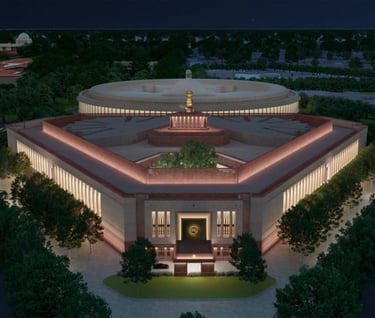New Temple of Democracy : Symbol of Jana-Gana-Mana
Inauguration of Newly Built Parliament House of India
CURRENT AFFAIRS
6/22/20232 min read


The inauguration of the new building of Parliament House was done on 28th May 2023.
The foundation stone of the new Parliament House was laid on 10th December 2020.
The new Parliament House is 64,500 square metres in size and embodies the spirit of "Ek Bharat Shreshtha Bharat".
The Lok Sabha chamber has seating capacity of 888 MPs.
The Rajya Sabha chamber has seating capacity of 384 MPs.
The Joint Parliament session has seating capacity of 1272 MPs.
The new Parliament House is designed by Padma Shri architect Bimal Patel.
Delhi is currently in Seismic Zone 4. The design of new building has been prepared for Seismic Zone 5.
Wood from Nagpur is used.
Marble of Gujrat is used.
Stone work is of Rajasthan.
Bamboo wood flooring from Tripura.
Hand-woven carpets have been fitted from Bhadohi, Uttar Pradesh. Bhadohi is known as 'Carpet City'.
National Bird : Peacock-themed Lok Sabha Hall.
National Flower : Lotus-themed Rajya Sabha Hall.
National tree, the banyan, has been planted on the premises of the Parliament.
Ashok Chakra is made on the gate of the new Parliament House and Satyamev Jayate is written.
Six entrance doors named as
Makar Dwar - salutation to water
Hans Dwar - salutation to water
Shardul Dwar - salutation to the sky
Garud Dwar - salutation to the sky
Ashwa Dwar - salutation to the sky
Gaj - Dwar - salutation to the sky
Ashoka Pillar : The national emblem on the roof of the Parliament House was unveiled on 11th July 2022. This is made of bronze, weight - 9500 kg, height - 6.5 metres.
Sengol : Sengol, symbolizing the transfer of power, is placed next to the Speaker's chair in the Parliament House with Vedic chants.
On the night of 14th August, 1947, Pt. Jawaharlal Nehru received the 'Sengol' as a symbol of the transfer of power to the government from the specially arrived priests from the Thiruvaduthurai Adheenam in Tamil Nadu.
'Sengol' is derived from the Tamil word 'semmai' which means 'righteousness'.
The person who receives the 'Sengol' has the 'Order' to rule justly and fairly.
In the Great Chola Empire, 'Sengol' was considered as a symbol of the path of duty, the path of service and the path of the nation.
